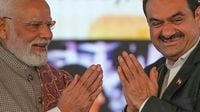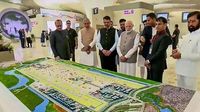On October 8, 2025, a new chapter began for India’s aviation sector as Prime Minister Narendra Modi officially inaugurated the Navi Mumbai International Airport (NMIA), a sprawling, state-of-the-art facility that marks Mumbai’s emergence as the only metropolitan area in the country with two international airports. According to the Associated Press, the inauguration not only signals a leap forward for Mumbai’s infrastructure but also reflects the rapid transformation of India’s air travel landscape in recent years.
The Navi Mumbai International Airport, developed by the Adani Group at an estimated cost of $2.2 billion (approximately INR 19,650 crore), is India’s largest greenfield airport project. The airport is strategically located in Panvel Taluka, about 46 kilometers from the existing Chhatrapati Shivaji Maharaj International Airport (CSMIA) and roughly 120 kilometers from Pune. Spanning over 1,160 hectares, the facility is designed to accommodate the surging demand for air travel in the world’s most populous country, as reported by multiple outlets including the AP and Times of India.
During the inauguration ceremony, Prime Minister Modi emphasized the project’s significance, stating, “It’s a reflection of a nation that is growing.” He also highlighted how the airport, alongside other major transit projects, would “strengthen the city’s position as a global hub of growth and opportunity” and improve the ease of living for millions of Indians, according to Bloomberg. The event drew the attention of national leaders and business magnates, including billionaire Gautam Adani and his son Jeet, both of whom accompanied Modi on a tour of the newly built facility.
The airport is set to begin commercial operations in December 2025. Its initial phase will feature one terminal, but plans call for a total of four terminals and two parallel runways, enabling the airport to handle up to 20 million passengers annually at first and scaling to 90 million as subsequent phases are completed. The facility can also manage an astounding 3.25 million metric tonnes of cargo per year, a figure that positions NMIA as a key passenger and cargo hub in Asia.
India’s aviation sector has witnessed dramatic growth over the past decade, with the number of airports in the country soaring from 74 in 2014 to 160 by 2025, official data show. The International Air Transport Association reports that India is now the world’s third-largest air transport market by departing passenger traffic, trailing only the United States and China. In 2024 alone, approximately 174 million passengers traveled by air within and from India, accounting for about 4.2% of the global total.
The new airport is expected to play a crucial role in alleviating congestion at the overcrowded Chhatrapati Shivaji Maharaj International Airport, which is hemmed in by dense urban development. By providing a modern alternative, NMIA aims to streamline air travel for both domestic and international passengers, while also offering faster access for travelers from neighboring districts such as Vashi, Alibaug, Thane, Karjat, and Lonavala. A new link road along the Mumbai-Pune Expressway is anticipated to reduce travel time from Pune to NMIA by roughly two and a half hours, significantly improving regional accessibility.
Connectivity is a defining feature of the new facility. NMIA will be the first airport in India to integrate water taxi services, in addition to high-speed rail, underground metro trains, and extensive highway networks. Several major thoroughfares—including the Sion-Panvel Highway, Palm Beach Road, Amra Marg, and the Mumbai Trans Harbour Link—will connect the airport to various parts of Mumbai and beyond. A 21.8-kilometer Ulwe Coastal Road, currently under development, will further enhance connectivity by linking western and southern Mumbai directly to the airport via the Atal Setu.
Architecturally, the airport is a showpiece. Designed by Zaha Hadid Architects, the same firm behind Beijing Daxing International Airport, the terminal draws inspiration from India’s national flower, the lotus. Glass facades and patterned lattice screens (jaali) are used to maximize natural light while keeping interiors cool. The airport will also feature artworks inspired by Maharashtra’s rich history and culture, with two museums planned beyond the security check area.
Sustainability is a core principle of the NMIA project. The airport boasts solar power installations generating around 47 megawatts, dedicated storage for Sustainable Aviation Fuel (SAF), and electric vehicle bus services. The Automated People Mover (APM) system will connect all passenger terminals and city-side infrastructure, ensuring smooth transit throughout the sprawling complex. These features, as reported by Times of India, position NMIA as a model for eco-friendly airport design in the region.
When it comes to flight operations, the airport is already attracting prominent carriers. IndiGo, Air India, and Akasa Air will be the first airlines to operate from NMIA. IndiGo plans to launch with 79 daily flights, including 14 international routes, by March 2026, and aims to expand to over 100 daily flights across 15 cities by November. Air India Express will ramp up from 20 domestic departures to 55 daily flights, including five international services, by mid-2026. Akasa Air will begin with around 100 domestic flights per week, scaling up to more than 300 domestic and 50 international flights weekly. The airport’s IATA code is NMI, and its ICAO code is VANM, distinguishing it from Mumbai’s existing CSMIA, which uses the code BOM.
NMIA is not just an aviation project—it’s a catalyst for broader economic and urban development in Navi Mumbai and the surrounding region. The airport is expected to boost real estate development, attract investment, and create thousands of jobs. According to Arun Bansal, CEO of Adani Airport Holdings Ltd, the group plans to invest an additional Rs 300 billion in the second phase of the airport’s development, further underscoring the facility’s central role in India’s infrastructure ambitions.
The inauguration of NMIA comes as part of a larger push by the Indian government to modernize transit systems nationwide. On the same day, Modi also inaugurated the final phase of Mumbai’s newest metro line, which features the city’s first underground track and connects the southern peninsula to the northern suburbs. This project will help alleviate severe overcrowding on Mumbai’s rail system and congested streets, and will eventually link to the Bandra Kurla Complex, the city’s major business district and the future terminus of India’s first high-speed rail line to Ahmedabad.
As India continues to invest billions in infrastructure and logistics, the opening of Navi Mumbai International Airport stands as a testament to the country’s ambitions and its growing stature on the world stage. With its blend of cutting-edge technology, sustainable design, and robust connectivity, NMIA is poised to redefine the air travel experience for millions and anchor Mumbai’s position as a global gateway for years to come.



